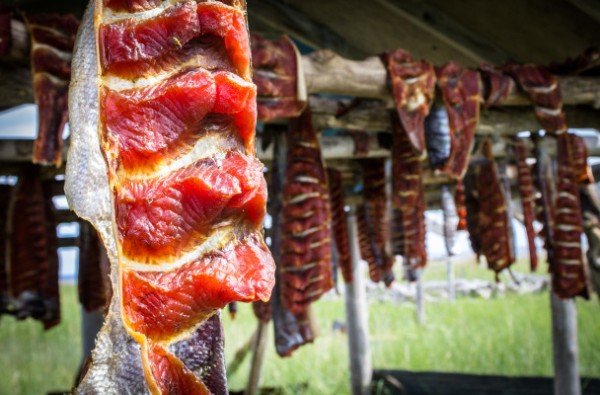The chinook have reached Canada, and Alaska Fish and Game biologists say they’ve now met nearly all escapement goals along the Yukon and are confident they’ll see enough of the prized king salmon cross the border.
“Passage estimates at the sonar project near Eagle indicate that the first and second pulse of Chinook have migrated across the border and are on their way to the spawning grounds in Canada,” fisheries biologist Holly Carol said during the weekly Yukon fisheries teleconference organized by the nonprofit Yukon River Drainage Fisheries Association.

Carol added that roughly 36,000 Chinook have so far passed the upper river sonar facility near Eagle. That puts the midpoint of this year’s Chinook run passing Eagle by Wednesday, July 22. The minimum escapement of roughly 42,500 kings into Canada is likely to be met by the end of this week, Carol said.
That’s enough to meet salmon sharing treaty obligations with Canada set forth in the 1985 Pacific Salmon Treaty.
Stephanie Schmidt, the summer season management biologist for ADF&G during the summer chum and Chinook run, extended her thanks to fishermen who worked—and sacrificed—to ensure the kings made it upriver.
“Fish and Game and the U.S. Fish and Wildlife Service would like to extend our thanks and appreciation to the fishermen of the Yukon River. We’re getting the number of Chinook salmon on the spawning grounds that we need to sustain this run,” Schmidt said.
Beyond hitting those escapement numbers, Schimdt added the quality of the fish—overall larger, and made of up about 43 percent female—means a healthy population is making it upriver.
“They’re seeing king salmon larger than they’ve seen … in recent years,” she added. “We seem to be getting not only good numbers of fish, but also good quality of fish on the spawning grounds as well.”
Meeting escapement goals is good news, but subsistence fishing on the Yukon has otherwise reached a midseason lull. Summer chum have officially run their course, and many fishermen calling in to the teleconference said subsistence is more or less on hold as fishermen await fall chums.
“I don’t think there’s anybody fishing in Galena,” said a fishermen who identified himself as Fred. “Most everybody waiting for fall chum.”
“There’s just not a lot of fishing activity, I think people are kind of holding off for fall chums and stuff,” said Richard in Kaltag.
Basil in Marshall agreed. “Not much subsistence activity … everybody’s pretty much just holding up ‘till fall chum and coho get here.”
On the upper river—where summer chums rarely swim—it’s been a season of nearly complete closures that’s just now opening to limited incidental takes of Chinook. But the openings are brief—just 24 hours—leaving fishermen like Andrew in Fort Yukon asking for more time.
“We did have a 24 hour opener over the end of the weekend here, Sunday, and people kind of felt it wasn’t worth going to fish for 24 hours,” he told fishery managers. “I think if they have another opener, some folks would like, maybe, a 36 hour opener or something, to make it worth their time to go out and fish.”
On the upper river, “it takes a little longer to do much on the Yukon Flats compared to other areas of the river,” he added.
Managers on the call said additional openings for the upper river will likely stay at 24 hours—as the final pulses of Chinook pass through the upper river.
Kings crossing the border, however, signals fall chums in the lower river. The first pulse of late-season chums passed the Mountain Village test fishery Saturday, and should be in the water near Russian Mission by Thursday.
Jeff Estensen with ADF&G said fall chums should run between 700,000 to 800,000 fish in the coming weeks. “With an outlook like that, [it’s] certainly adequate … to meet our escapement needs, provide for subsistence, and provide for a commercial harvest.”
Commercial openings are already happening in the lower river, with Y1 and Y2—roughly from Emmonak to upriver from St. Mary’s—already seeing twice weekly commercial openings. Estensen said a single 6-hour opening Monday saw fishermen harvest about 3,500 fall chum.
Matthew Smith is a reporter at KNOM in Nome.




